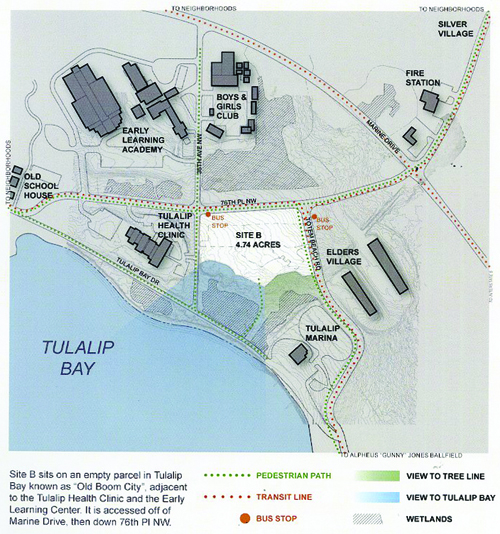Category: News
Community Open House on Tulalip Reservation Land Use, March 9
Celebrate Valentine’s Day: A Contemporary Love Affair From Rock N’ Roll Romance To Sublime Dining
Options Combined with Mesmerizing Music
Tulalip, Washington – Tulalip Resort Casino knows how to translate the feelings of love. From events like the Rock Ballad Ball featuring Guns N’ Roses and Aerosmith tribute bands; to seven award-winning food and beverage outlets that feature Valentine inspired Sous Vide Lobster Medallions or Asian-infused dining fare, Tulalip Resort Casino has just what the love doctor ordered.
The Rock Ballad Ball is an out of the box extravaganza offered to the young – and the young at heart. This annual February 14th Valentine’s Day party includes a concert of tribute bands (Appetite for Deception and Aeromyth) featuring music from legendary greats Guns N’ Roses and Aerosmith. Doors open at 6:30 pm with DJ tunes. Dinner starts at 7 pm in the Orca Ballroom where guests can savor a buffet spread offering a selection of two salads, chicken or prime rib entrees, a selection of side dishes (grilled vegetables, penne pasta, mashed potatoes), assorted desserts and coffee/tea. Admirers and their main squeezes can dance the night away to rock pounding sounds starting at 8 pm.
Aeromyth has become known as the top Aerosmith Tribute band worldwide! Playing nationwide as well as International dates such as Mexico, Canada and El Salvador since 2002. Chris Vandahl does an amazing portrayal of Steven Tyler, including all of his dance moves, costumes, stage show and amazing recreation of Tyler’s outrageous vocals! Chris looks so much like Steven Tyler that many people make the mistake of thinking he really is the Aerosmith front man! The band that backs Chris is truly amazing as well, very solid and tight, recreating the music fans know and love – note for note! For more information about the band, visit aerosmithtribute.com.
Appetite for Deception fans are blown away by the attention to detail and variety of material this band delivers. Appetite for Deception strives for authenticity in all aspects of their live performance – the gear, clothes and precision of the songs included. Everything is in place to take the listener and viewer back to the heyday of Guns N’ Roses. Nearly 20 years to the date of Guns N’ Roses’ formation, Appetite for Deception was put together in Portland, Oregon by five musicians looking to continue their great legacy. The tremendous catalog of music helps to make every show a roller coaster ride of high energy and intense emotion as the memories of that era are brought back to life. For more information about the band, visit appetitefordeception.com.
Rock Ballad Ball is for those 21 and over and offers a no-host bar and festival seating. All-you-can-eat Dinner Buffet and concert tickets are priced at only $75 per person, including tax and gratuity. Tickets must be purchased in advance. To purchase Valentine’s Day Rock Ballad Ball tickets, visit ticketmaster.com or the Casino Box Office (where no additional ticket processing fees are added). Additional details can be found at Rock Ballad Ball.
Prefer something a little more intimate and less ‘rockin’ for a romantic getaway? Tulalip is offering exclusive holiday offerings at two of their world-class restaurants.
Guests can travel to Journeys East where Asian inspiration meets Tulalip hospitality with a blend of cuisine and culture in a modern, Zen-like setting. Wood, metal and glass combine to offer unmatched harmonious décor. A centrally located display kitchen features offerings from Japan, Thailand, China, Korea, and Vietnam. Enjoy handcrafted cocktails, a phenomenal sake selection and award-winning wines.
Valentine’s Day weekend dine-in specials will include Journeys East Wok Finished Lamb Chops as well as the restaurant’s signature Shrimp Hargow Dumpling. These dishes will be available in addition to the regular dinner menu from 5 pm until closing on February 12-14, 2016. To reserve a table online, visit OpenTable, or reserve by phone at 360-716-1880. No passport required – just an appetite for a delectable experience.
Gals and guys can also wow their lover with the Tulalip Bay restaurant – a winning combination of classic steakhouse meets traditional Italian with a superior wine list. Discover what magic occurs when old world taste is fused with local Northwest ingredients. The menu is filled with many delectable culinary twists from prime cut steaks and chops to freshly prepared seafood and classic Italian specialties.
This year’s Valentine’s Day Tulalip Bay dinner special for two includes the Sous Vide Lobster Medallions (due to long cooking time, pre-reservations requested) and a Sea Scallop Mousseline with avocado risotto, glazed thumbelina carrots, lobster air, and caviar along with two special cocktails of Prosecco and prickly pear foam. The special will be available in addition to the regular dinner menu from 5 pm until closing on February 14, 2016. To book a table online, visit OpenTable, or reserve by phone at 360-716-1500.
Whatever floats the proverbial Love Boat this year, Tulalip has it covered!
Exploring potential sites for Gathering Hall
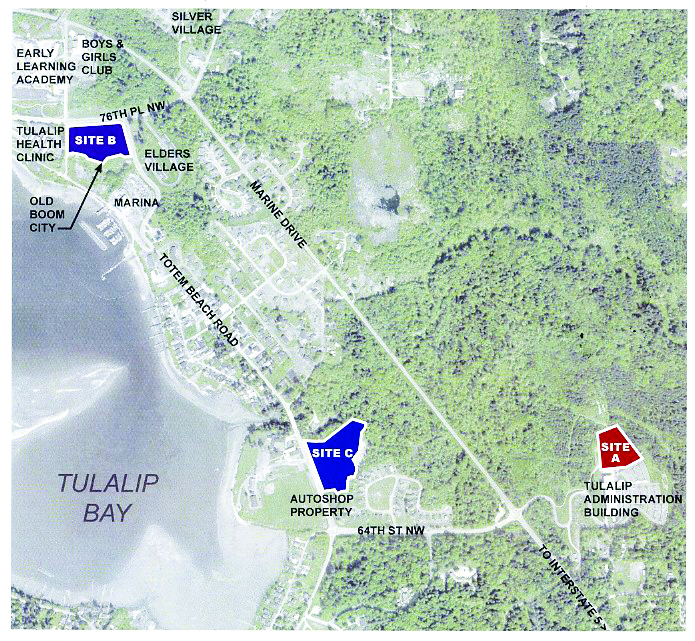
By Niki Cleary, Tulalip News
If you attend tribal gatherings on a regular basis you’ve probably heard concerns about the fact that we hold funerals in the same places that our kids play. You’ve heard frustration that one event was cancelled to make room for another. You may have opted not to rent a building for your birthday or reunion from the tribe because of the potential that it would be cancelled. What if we had a place dedicated to gathering together? Somewhere to celebrate, meet about the governance of our tribe and hold ceremony, as well as a place to hunker down together in case of an emergency or natural disaster. A Gathering Hall has been on the community wish list for years and now it’s becoming a reality.
For Executive Director of Housing, Jay Napeahi, the Gathering Hall is one more step in building shared spaces and walkable neighborhoods within the heart of the reservation. Jay’s department is also planning for parks, walking trails, neighborhood stores and other amenities.
“It only makes sense, if we’re bringing people out here [to live], that we serve that population. We want to provide services so that you don’t have to leave the reservation. We want to bring services back to the marina. At the Everett Marina, for example, you have places for fishermen to do things, eat and get supplies then get back on the water. If you’re a fisherman, our marina is not really serving that purpose, other than mooring your boat. You can’t get supplies or refuel.
“Raising kids, when we were walking around we just wanted a place to get something to drink, or change your kid, maybe someplace to watch the wildlife and enjoy the area. We always thought it was important to walk trails. [Cultural Resources] used to have a historic pictograph trail. We’re developing to bring that back to the area.”
On January 23rd, the Housing department presented potential sites for the Gathering Hall to the community and asked for community input.
The three sites under consideration are: The Administration Building – Site A, “Old Boom City” – Site B, and “Autoshop” – Site C. The architects who reviewed the sites evaluated each for: relationship to the community; ease of access and connectivity; challenging site conditions; views provided to and from the properties; potential impact on adjacent residents and businesses; and public safety hazards. None of the sites are perfect, and none are significantly more expensive to develop, which is why it comes down what people want.
While the plans for the building aren’t complete, there are some general ideas about the size. The gathering hall itself, not counting lobby, offices restrooms, etc., is estimated at 14,000 square feet. For comparison, the Orca Ballroom is 12,000 square feet. It has a capacity of approximately 2,000 people and will include 428 parking stalls. The kitchen is an additional 10,000 square feet and includes spaces for cooking, cleaning, banquet set up, storage and support areas.
Site A – the Administration Building
When the current Administration Building was constructed, the site was prepped with plans to house a gathering hall as part of future expansion. This means that the site already has utilities, and the Administration Building generator was oversized to serve an additional building. It’s also right next to much of the existing services provided by Tulalip and Tulalip Transit services the area, and both buildings can share parking. Because of its elevation, the soils are better for building and high water table and wetlands are not as much of an issue.
The downside of the site is that it’s right next to one of Tulalip’s primary workspaces and gatherings may impact the workforce. Also, there is a single road currently entering and leaving the site. While another road can be constructed, the steep grade of both roads is a concern in winter and bad weather. For funerals, walking to the cemetery would likely not be an option due to the grade of the hill and distance from the cemetery.
Site B – Old Boom City
This site provides some of the best views of the bay. It’s proximity with the Karen I. Fryberg Health Clinic, Betty J. Taylor Tulalip Early Learning Academy, Tulalip Boys and Girls Club, Elders Village and the Marina mean that it’s centrally located and already a commonly accessed area. The site holds many fond memories for the community and was a favorite in the room.
The cons of this site include its natural composition. Surrounded by wetlands and fill soils, it’s not the ideal site for building. Much of the fill would need to be removed and replaced, and wetlands would have to be mitigated. In order to accommodate the size of the building and parking, the road may need to be moved. For funerals, walking to the cemetery would be a challenge. Additionally, the area has previously been proposed as a community park, if chosen for the gathering site, it would no longer be available as a park site.
Site C – Autoshop
Centrally located near the Don Hatch Youth Center, the Autoshop site seems ideal for many events. It’s within walking distance of the cemetery and several neighborhoods, and is serviced by public transportation. The site can be built to provide shared parking between the Youth Center and Gathering Hall, and both spaces can be opened for a campus feel during some events. There are currently adequate utilities and good road access to the site.
Unfortunately, the shared space can also be a detriment when two events happening at the same time have a different feel, for example, a funeral and a tournament. The shared parking can mean that simultaneous events can put the parking lot over capacity.
Community comments
Approximately 10 community members attended the meeting; four gave input. Most of the comments focused on the need to be connected to the bay, and the potential expense or workability of the sites. Jay assured the community that each of the sites is workable, and while the price tags may look big or small, from a personal budget standpoint, none of the sites is cost prohibitive.
The below comments were provided by the four community members who spoke.
Site B, Boom City – Re: the size of the site
“That’s not a big challenge, you’ve got land above and across the road, below you have to worry about the fill.” Don ‘Penoke’ Hatch
Site A, Administration – Re: the cost of the sites
Does one cost more or take longer? No, about the same? The Admin Sit is the least costly site to build on relative to the other two.” Willa McLean
Site B, Boom City – Re: proximity to Tulalip Bay
“We’re water people. We don’t barely have any place to look at the water, we have a limited amount of space for tribal members to make use of, we should look at it as a tribe. I think we should be close to the water.” Virginia Carpenter
Site C, Autoshop – Re: parking
“If you utilize the parking, you eliminate activities at the gymnasiums.” Don ‘Penoke’ Hatch
Site C, Autoshop – Re: parking/current facilities
“I don’t think there’s a conflict if we add more than 428 stalls. This is the only site that would displace existing business. I personally think we need more than 428 stalls.” Margie Santibanez
Site C, Autoshop – Re: previous intentions for the site
“Ginny, you probably remember when your dad was on there. Part of that was dedicated to recreation. They already got that on recreation land That’s dedicated by our ancestors to take care of recreation. Years ago, by our ancestors, that was dedicated, that land. I don’t know how far it went, but it’s there.” Don ‘Penoke’ Hatch
Site C, Autoshop – Re: current uses
“If we have that in mind for multiple events, why hasn’t the Board thought about centralizing Auto Maintenance and make that a true youth campus or get rid of Auto Maintenance and uproot it and put it somewhere else.” Willa McLean
All sites – Re: costs
“I know you said don’t be motivated by costs, but do you have a cost figure?” Margie Santibanez
Response: the lease expensive site is the Administration site, next is the Authoshop site, the most expensive is the old Boom City site.
Site A, Administration – Re: proximity to Tulalip Bay
“You can’t see the water from here, that’s out, we need to be on the water.” Willa McLean
Site C, Autoshop – Re: shared use
“I think we should be looking at the building separate from recreation because now, when we have a funeral, we are looking for parking. It should be totally separate from the ballfield. Too much congestion.” Virginia Carpenter
Site B, Boom City – Re: emergency uses
“The Early Learning Center, the Boys and Girls Club, our kids could just run to that building.” Virginia Carpenter
Site B, Boom City – Re: site work
“Boom City, move the road up, eliminate the road, and bring the two roads down and you can make it happen. Cut to the chase, we can go over and over, just move the road up and move the building up. I realize it’s wet grounds, I worked at the Boys and Girls Club and helped put it in, I think we aught to just cut to the chase. Look at all the congestion we have now. I don’t want people trying to do their job there, or at the Y-site, you have people playing basketball, soccer and people praying across the road.” Don ‘Penoke’ Hatch
All sites – Re: building uses
“Do we have a marketing plan for the Gathering Hall? Not just used for funerals…as a tribal member, if I make a decision, I want to look at the whole. Are we using it for General Council? I’m looking at how it’s going to impact elders, etc.” Margie Santibanez
All sites – Re: extravagant building
“We as Tulalip people want to have a Rolls Royce every time we build a building, I don’t think we need to spend the money every time. We just need a Ford or Chevy, we don’t need one where we have everything in the building. I think we’re looking at it. Look at some of the buildings we built, but that Early Learning Center was so expensive and almost run us broke. We need to make sure we have a Ford or Chevy not a Rolls Royce, so we can have it and get it built. We don’t have to have something seems like we’re outshining Puyallup and Muckleshoot. It’s a gathering hall, we’re going to sit comfortable, we always want to have something better than someone else.” Don ‘Penoke’ Hatch
Site B, Boom City – Re: wetlands/emergency management
“William was talking about what they did with building the Clinic, they had to run the runoff to the lower pond. Might have to do likewise and run the runoff to the lower pond, so the fish would go to the lower pond and not the runoff of where the clinic is. I appreciate what Virgnia was talking about, the safety factor, look at where the children are at the Boys and Girls Club, they could walk right to that building, if you look for the biggest part for the safety of our children.” Don ‘Penoke’ Hatch
All Sites – Re: Cost
“With the ELA because it cost nearly twice as much as it should, should consider hiring a superintendent. I’m living in the construction world right now, I’m learning about , it’s all right to have people working on the interim, but we need people to work on that problem, we have over and over and over.” Willa McLean
“The biggest thing is have a good architect so that what is requested is put in there, because if we want to change it’s on the tribe. But the district, on the school board, we made sure we had that architect that knew what he or she was doing, if we allow that to happen, that’s what happen on this early learning center, there were so change orders.” Don ‘Penoke’ Hatch
Site B, Boom City – Re: including existing departments
“I agree with the Boom City site, but bring in your departments, we know we need to replace the utilities in that area, get it all together so that everything that is going to impact is up front. That’s the problem, we break ground then oh, we need this person in there.” Margie Santibanez
If you would like to provide your input, there is still time. Please email Jay Napeahi at Jnapeahi@tulaliptribes-nsn.gov.
MOA a new pathway to keep children with their families
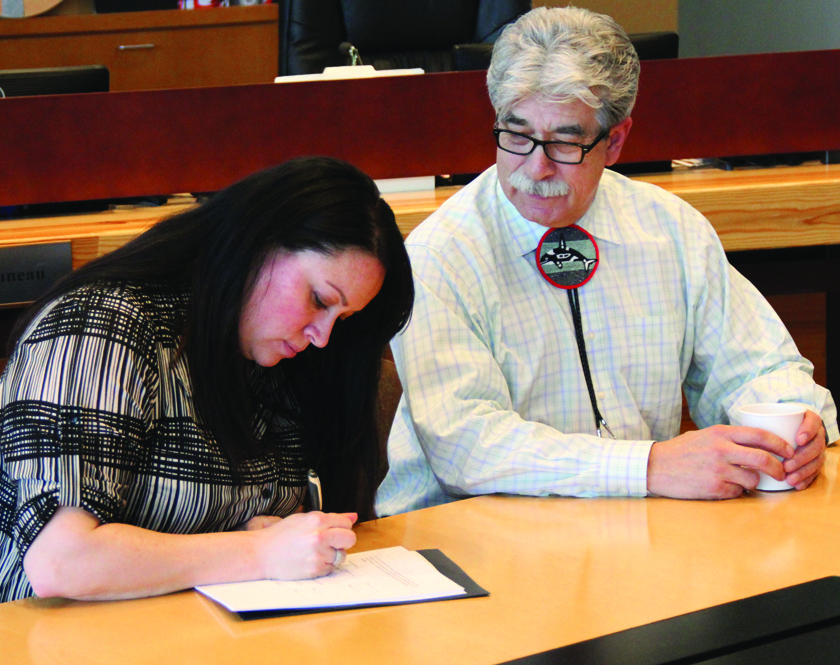
Photo/Micheal Rios
by Micheal Rios, Tulalip News
Few events are more traumatic for children than being removed from their families and entered into the foster care system. The trauma is even worse for Native children because usually when a government agency removes a child, they take them from not only their family but their culture and reservation as well. Such displacement can often lead children down a path to a deeply troubled life.
Here in Tulalip, like countless reservations across the United States, we’ve been forced to bear witness to tribal parents losing their tribal children to the State, of families being torn apart because of a government agency who knows very little about the Native way of life.
There are a lot of Native citizens who don’t understand how this continues to happen, since Congress passed the Indian Child Welfare Act in 1978 in an effort to stop Native families from having their children removed by the State and local officials for invalid and misconstrued reasons. Yet 38 years later, Native children are still much more likely to be removed from their families and placed in foster care than non-Native children.
The Tulalip Tribes leadership, along with the Office of the Reservation Attorney, and beda?chelh, have long fought for a solution that accurately reflects Tulalip values while being anchored by our inherent sovereignty. Back in 2011, the Tribe entered their first formal child welfare agreement with the State, but that was a general boiler plate model that laid the groundwork for a specifically Tulalip tailored agreement to follow. After years of steadfast dedication and due diligence, the solution may have finally arrived in the form of an updated government-to-government child welfare agreement between the Tulalip Tribes and the State of Washington. The agreement is reflective of Tulalip’s cultural values, aims to keep families together, and, as much as possible, minimize disruption to tribal children. The official agreement was signed into effect on January 13, 2016 by Chairman Mel Sheldon, General Manager Misty Napeahi, and officials from the Washington State Department of Social and Health Services and the Children’s Administration.
The signed agreement formalizes the government-to-government relationship between the Tribe and the State with child welfare cases. It’s based on the fundamental principles of the government-to-government relationship acknowledged in the 1989 Centennial Accord and recognizes the sovereignty of the Tribes and the State of Washington and each respective sovereign’s interests. What does this mean? It means the State of Washington now officially recognizes Tulalip has jurisdiction over Tulalip children wherever found and that Tulalip desires to assert its jurisdiction and authority to protect Tulalip children and keep families together whenever possible.
“I would like to thank everybody for coming out today and pay a special tribute to Michelle Demmert, our reservation attorney, for all the hard work she has done and for understanding my vision to protect our children and families,” said Misty Napeahi, General Manager of the Tulalip Tribes, during the document signing. “With this agreement we are doing what’s in the best interest of Tulalip children. That’s who we are here for. This is a road map that will help guide us and allows us to work in the best interest of our children.”
The overarching purpose of this agreement is the safety and well-being of Tulalip Tribal children. To this end, the specific purpose of this agreement between the tribe and the state is to clarify the handling of Child Protective Services and Child Welfare Services cases involving Tulalip children and their families.
Pursuant to the Indian Child Welfare Act and our sovereignty, the Tulalip Tribes have jurisdiction to handle all child abuse and neglect cases for our children. Some may be wondering, haven’t we always had that jurisdiction? The simple answer is no. In certain situations state agencies were able to, and would, circumvent the tribe altogether in cases involving allegations of child neglect or abuse. Now, with this agreement in place, the tribe can no longer be circumvented. Going forward, any time a state agency comes to investigate an allegation of child neglect or abuse, a beda?chelh case manager will be on the scene.
For instance, if there’s a child abuse referral made by a teacher who sees something that isn’t good for a child. Say at school a child is coming in late all the time and one day comes in and has bruising on his face or arms. That teacher or school would call the CPS hotline and provide those details. That would trigger a series of events. If the child was Tulalip, then the State would notify beda?chelh and they would tag the case an emergency or not (24 hour vs. 72 hour contact by beda?chelh and State representatives). If it’s an emergency, then this new agreement lays out the State is required to contact beda?chelh and a beda?chelh case manager would need to be involved in the process from the get go.
This agreement ensures Tulalip staff and representatives are always actively involved in any and all cases involving our children, and that we are taking the lead when the opportunity is there. The bottom line is we want our primary goal to be child safety, and to make sure any services or treatment families are receiving is defined by the tribe. That’s why this agreement also lends itself to the creation of a Tulalip Family Intervention Team (FIT), which will contact families of low-risk assessment and provide skill based services to parent their children, so that no court intervention is necessary.
FIT aims to keep families together and act as a proactive solution offering culture based services to families, while getting parents actively involved. It’s a way to handle things more traditionally between the Tribe and the families.
It may be an agreement of this nature is long overdue, but it took many days and long hours from individuals across several different tribal and state agencies to carefully craft and fine tune in order to get it right, not just for Tulalip children and families, but for all Native children and families. With Tulalip leading the way, there are sure to be multiple tribes who model their own government-to-government child welfare agreements after this one.
“I would like to thank the Tulalip leadership that allows us to do our job and work in the best interest of this community and the children,” said reservation attorney Michelle Demmert. “So many voices do not have someone who is championing their cause. Being an attorney for 24 years people think I should be doing something else rather than focusing on issues involving children or domestic violence, but these are the issues where people do not have a voice in the community. They need someone who can speak for them and understand their situation. Being a Tlingit woman, I have that perspective and can bring out their voice. This agreement does that and so much more. It benefits not only the Tulalip families and community, but other tribes who will follow suit.”
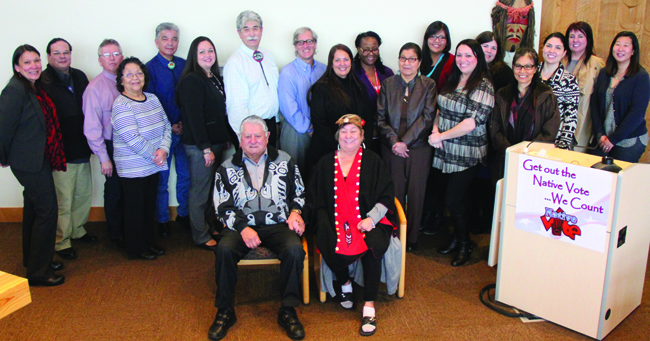
Photo/Micheal Rios
Contact Micheal Rios, mrios@tulaliptribes-nsn.gov
Northwest U.S. Treaty Tribes Fight Proposed Canada Oil Pipeline That Threatens Salish Sea
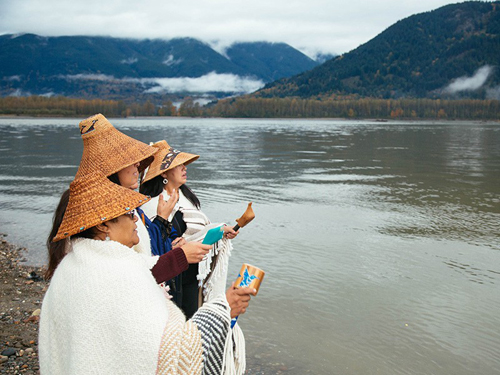
CHRIS JORDAN-BLOCH / EARTHJUSTICE
Representatives from four Northwest tribes argued against oil spill risks, destructive increases in oil tanker traffic, and threats to treaty-reserved fishing rights posed by project
Today’s arguments before Canada’s National Energy Board represent a critical and final call to safeguard the Salish Sea from increased oil tanker traffic and a greater risk of oil spills. Experts have acknowledged that a serious oil spill would devastate an already-stressed marine environment and likely lead to collapses in the remaining salmon stocks, further contamination of shellfish beds, and extinction of southern resident killer whales. If approved, the TransMountain Pipeline would instigate an almost seven-fold increase in oil tankers moving through the shared waters of the Salish Sea, paving way for a possible increase in groundings, accidents, and oil spills.
“We have a sacred duty to leave our future generations, our children, our children’s children, a healthy world,” said Mel Sheldon, Chairman of the Tulalip Tribes. “We will continue to oppose this project because it further threatens the Salish Sea with reckless increases in oil tanker traffic and increased risk of catastrophic oil spill.”
Tulalip Resort Casino Appoints Jeremy Taisey as Chef/GM of their AAA Four Diamond Tulalip Bay Restaurant
Source: Allan Aquila & Associates, LLC
Tulalip, Washington — Tulalip Resort Casino is pleased to announce the appointment of Jeremy Taisey as the new Chef/GM of their Four Diamond Tulalip Bay Restaurant — bringing new vision and experience to the operation. Prior to joining the Resort’s culinary team, Jeremy Taisey was cooking up cutting-edge fare at the Woodmark Hotel Kirkland, Las Vegas’ Bellagio Hotel, The Regent Hotel Beijing, along with the Pine Valley Resort in Beijing and other local area hotels.
“We are excited to bring Jeremy Taisey on-board,” states Executive Chef Perry Mascitti. “He possesses an incredible mixture of knowledge, creativity, and foresight that he will bring to the operation. Our guests are going to enjoy what he creates for them.”
Native to the Seattle area, Jeremy Taisey has always been fascinated by the happenings in the kitchen. It was during an Easter brunch at a local hotel that he decided to become a chef. The next day, Jeremy Taisey enrolled himself in the Edmonds Community College Culinary Arts program, which allowed him to fulfill his dream.
In 2006, Jeremy Taisey decided to pack his belongings and venture to Beijing, China, to marry his fiancé of three years. It was during his time in China that Jeremy Taisey’s career really took off. During his nomadic culinary journey, he cooked for many famous individuals, such as the Governor of Beijing, Israel’s Prime Minister, the Princess of Thailand, and actors Jackie Chan, Jet Li, and Christopher Lloyd.
Jeremy Taisey returned to his hometown in 2012, bringing with him a blend of unique experiences and an unparalleled skill set. His goals for the Tulalip Bay menu are to create seasonal dishes featuring modern interpretations of Italian meals, using local ingredients with a focus on top-rated prime steaks.
When Jeremy Taisey isn’t cooking up a storm in the kitchen, he can be found spending quality time with his wife and enjoying great food.
Tulalips, Forterra to preserve land near Wallace River for salmon
By Chris Winters, The Herald
GOLD BAR — A 1.25-mile stretch of forested land along the Wallace River will now be protected forever as salmon habitat.
The land, covering 121 acres on five parcels, was purchased by the environmental nonprofit Forterra in July for $490,000. Forterra, formerly known as the Cascade Land Conservancy, transferred the property to the Tulalip Tribes in November for future management.
A conservation easement ensures the property will never be developed.
“There’s a stewardship plan that we’ll be working on with the Tulalips” to maintain the tract’s value to the watershed, said Michelle Connor, Forterra’s executive vice president of strategic enterprises.
The property on the north bank of the Wallace River consists of five parcels that are a mix of wetlands and mature second-growth forests. It was last logged several decades ago.
“The trees have grown back nicely and the land is actually in pretty good shape,” said Daryl Williams, the Tulalip Tribes’ natural resources liaison.
The tract is located just west of Gold Bar and close to the Mt. Baker-Snoqualmie National Forest, the Wild Sky Wilderness and other protected lands managed by the state Department of Natural Resources.
The land lies across the Wallace River from a state salmon hatchery, and provides habitat for bull trout as well as four types of salmon: chinook, coho, pink and chum. The land is also home to black bear, elk, deer and beaver.
Williams said the land is likely to remain in its present state, as it already provides ideal habitat for fish in the water as well as for land mammals.
“Right now we don’t have any money to do anything with the property,” Williams said. “Perhaps we’ll thin some of the trees to allow some of the others to grow faster.”
The deal came together when Forterra learned the owner of the parcels, a property investment firm called Robinett Holdings, soon would put them up for sale, Connor said.
“When we first learned the property was coming on the market, we contacted the Tulalip Tribes to see if (the land) would be conservationally significant,” Connor said.
That turned out to be the case, she said.
“The property itself has historical oxbows and natural features that in and of themselves are very, very important,” she said.
It also fit in with the Tulalips’ efforts to restore the watersheds associated with the Snohomish, Skykomish and Snoqualmie rivers.
“We’ve been spending a lot of time and effort trying to restore areas on the watershed,” Williams said.
“With new development and redevelopment, we’re losing habitat faster than we’re replacing it,” he said. “We need to do a better job with what we have.”
The deal marks the second large habitat protection project the Tulalips have undertaken. Last year the tribes breached the levees and restored tidal influence to the Qwuloolt Estuary in Marysville. The 315-acre tract took 20 years to convert from farmland to a salt marsh and cost nearly $20 million.
The transfer of the Wallace River tract is also consistent with Forterra’s goals in working with local Native American tribes on preservation, Connor said.
Last year Forterra carried out a similar property transfer with the Makah Tribe involving 240 acres near Lake Ozette on the Olympic Peninsula that is considered critical salmon habitat.
“We see that repatriation of indigenous lands is an important part of our conservation mission,” Connor said.
Snohomish County was the primary provider of funds for the land purchase and transfer, providing $280,000 in Conservation Futures funds toward the purchase, and toward other costs associated with obtaining the conservation easements and transferring the property to the tribes.
County Parks Director Tom Teigen said the Conservation Futures Advisory Board often tries to strike a balance between acquiring land for active recreation, agriculture and habitat preservation, but this particular exchange stood out for its potential benefits to salmon.
“At the end of the day, preserving that property and getting that much acreage as well as the riverfront is significant,” Teigen said.
Forterra also received $250,000 from the state Recreation and Conservation Office toward the property purchase.
Unlocking Indigenous Knowledge
Burke Museum helping to revive lost traditions
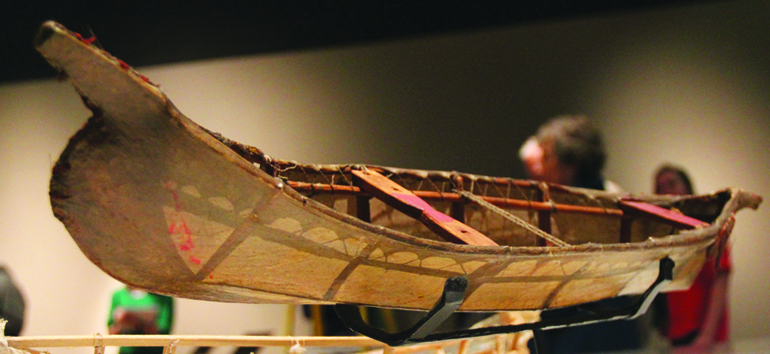
Photo/Micheal Rios
by Micheal Rios, Tulalip News
The Burke Museum, located on the University of Washington campus in Seattle, is home to more than 16 million historical artifacts and objects. The thing is, only a few thousand are on display on a daily basis. Of those millions and millions of artifacts hidden away in archives and storage rooms, there is no telling how many hold cultural keys that could unlock indigenous knowledge once thought lost or destroyed forever during colonization and European settlement.
Enter Dr. Sven Haakanson, member of the Alutiq people of Kodiak, Alaska. Sven is a world renowned curator of North American ethnology and currently the head of Native American anthropology at the Burke Museum. Sven has joined the Burke team to use the museum’s amazing collection and vast resources to find those keys to indigenous knowledge currently hidden away.
“For me, the real privilege is having access to such an amazing collection because when I look at ethnographic pieces I don’t see an art piece, I see a historic object,” says Sven. “I see something that we can use the museum as a way to bring back a lot of that traditional knowledge, that we thought was lost, and put it back into a living context.”
A prime example of rediscovering indigenous knowledge that was thought lost forever has been the finding of simple model boat. Well, it was thought of as simple and sat away in collections until Sven came across it and realized he had stumbled across long lost knowledge.
What he found was a model Angyaaq, which means ‘open boat’ to the Sugpiat peoples of Alaska. This model Angyaaq is one of only a dozen known to exist and hold secrets to a long ago mode of transportation. It demonstrates a lost building tradition, models the difference pieces needed, and material and engineering techniques used to build a full-size Angyaaq – like marine animal skins to wrap the hull and lashing to tie all the pieces together. This model is key to Sven unlocking and reviving a practice of boat making absent on Kodiak for nearly 200 years.
According to Burke researchers, the Angyaat (plural for Angyaaq) were an essential part of the Sugpiat peoples of Southern Alaska’s livelihood and culture for thousands of years. An open boat used for transportation, hunting, trading, warring and more. Angyaat were a symbol of prosperity and wealth. Remnants of these boats are present in archaeological sites; yet, by the 1820s, roughly twenty years after contact, Russian settlers had either taken or destroyed all Angyaat in an effort to restrict the Native peoples’ ability to move, gather in large numbers, and display their wealth and power. Due to this destruction, very little is known about a type of boat once common on Kodiak Island.
What Sven set out to do was first make successful models of the model, in an effort to teach himself how to build the open boat without the use of modern methods. “No nails, no glue” in order to replicate and then teach the traditional way. After many intricate sketches and even more attempted models later, Sven had taught himself how to replicate the Angyaaq model using the same traditional techniques. The next phase is to use the model to build a full-size, working boat.
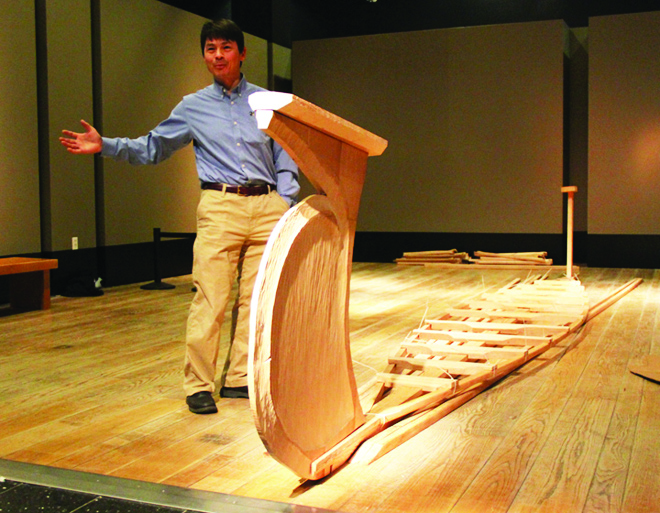
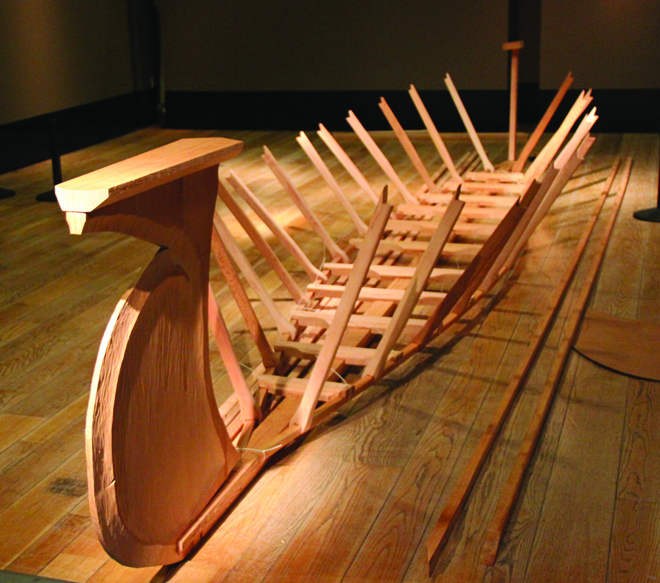
“By building this traditional boat in the traditional style, we are taking information that was lost from my community in the 1800s and figuring out innovative ways restore that indigenous knowledge,” explains Sven. “We are not just reverse engineering the model, but we will build a full-size one so we can share that information back into the communities from which it came. This is just one example of thousands that we can do for the next 100 years for our local Native communities both here in Washington and in Alaska.”
“The amazing can happen when you look at these museum objects not just as beautiful art pieces, but think about the history embodied in them. Think about what it means to the indigenous peoples and how they can then take this lost knowledge and re-embrace it while celebrating it. For me, it’s a process of rediscovery, of looking at how innovative, how adaptive, and how scientific my ancestors were. In that, this Angyaaq is just one example of who knows how many others we have and haven’t explored yet. I’m hoping this will be a catalyst for asking even more questions and continue to be innovative as we search through the past.”
Over the summer, Sven will travel to Kodiak Island to work with tribal members on the construction of several model Angyaat, with the goal of training students how to build a full-size, working boat in the future. Practicing this reconstruction with community members is helping share Sugpiat heritage and traditions, restoring knowledge that’s been lost, and providing a research model for others around the world to emulate.
Until then, Sven with continue to hone his Angyaat building skills as he hosts a live exhibit that can be witnessed by all. Witness the revival of a lost practice as part of a special month-long program at the Burke Museum. Visitors can see the finished Angyaaq in the Maker-Market from December 20 – January 3. Check burkemuseum.org/maker for the up-to-date boat construction schedule.
Tulalip turning tide on diminishing salmon
It has been 100 years since water flowed in this now former farmland along Ebey Slough. The place is unrecognizable from what it was just four months ago.
“A lot of things are going to change really fast in here,” said Todd Zackey, as he and a team of researchers from the Tulalip Tribes navigated the waters Monday.
In August, the Tulalip, along NOAA and Snohomish County breached a levee along the slough, flooding the land and returning its natural state.
Now, researchers are casting nets into the water to see what fish are showing up. The goal is to create a salmon spawning habitat to help in increase their numbers around Puget Sound.
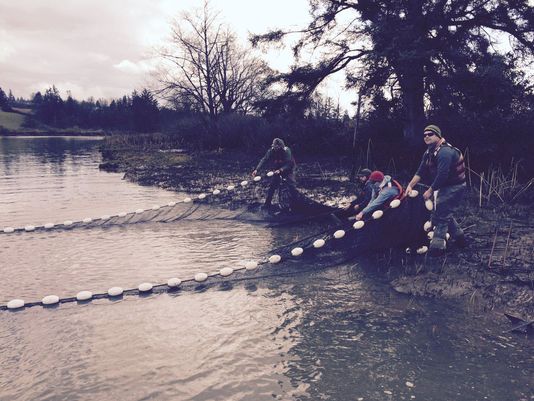
(Photo: Eric Wilkinson / KING)
Right now, though, there are far more questions than answers.
“Can we punch a hole in the dike and have the salmon respond in a positive way?” asked researcher Matt Pouley. “Are we going to see a population response over a reasonable amount of time?”
So far only a few salmon have been spotted, but that’s to be expected for this time of the year. There are plenty of other fish, though, and that’s a good sign.
No one is in a hurry. This is a long term project. It will likely take a century for full restoration of these waters.
And this project is about more than strengthening the fish supply. It’s about a way of life that goes back thousands of years for the Tulalip, and preserving that tradition for generations to come.
“The tribe is, in essence, losing part of its culture,” said Zackey. “Restoring salmon is restoring the culture of the tribe.”







